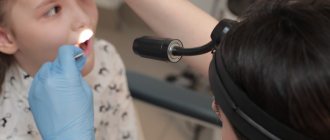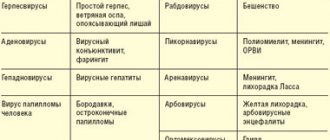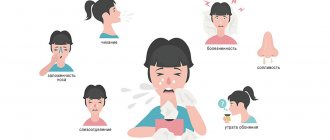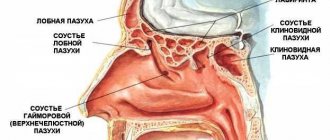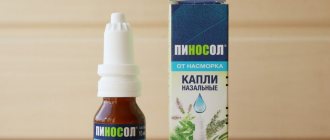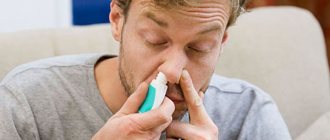Allergic rhinitis
The content of the article
This is the most common cause of frequent sneezing. The nasal mucosa is the first barrier to any foreign agent. It is not surprising that it is the most severe manifestations of allergies.
Provoking agents include house dust with mites inhabiting it, plant pollen, aerosols, pet hair and many others. Immediately after contact with the allergen, the mucous membrane swells, mucus production increases sharply, all this causes a protective reaction in the form of “apchha”.
As a rule, an allergic sneeze is long-lasting and can persist until exposure to the allergen stops or an antihistamine tablet takes effect.
What to do? Visit an allergist and get tested. Identifying the allergen will help avoid unnecessary exposure and reduce medication consumption.
Treatment
Help before diagnosis
For a common runny nose caused by ARVI, special treatment measures are not required. It is necessary to use saline solutions to rinse the nasal cavity to remove pathogen particles and exudate and moisten the mucous membrane. If you feel stuffy and have difficulty breathing, you can use vasoconstrictor drops for no longer than 7 days, strictly following the instructions.
To reduce allergic sneezing, you should limit contact with irritating factors: spend less time outdoors during the flowering period of trees, regularly do wet cleaning to get rid of dust. When allergic rhinitis worsens, it is advisable to exclude foods that increase the production of histamine (strawberries and citrus fruits, chocolate and coffee, peanuts).
Conservative therapy
Topical treatment is selected to reduce sneezing and other nasal symptoms. There are several types of nasal drops, the selection of which takes into account the causes of rhinitis. For patients with diseases of bacterial etiology, antimicrobial drugs are recommended; for viral diseases, immunomodulators and interferons are recommended. To quickly cope with allergic sneezing, there are nasal sprays with corticosteroid hormones.
Systemic medications are prescribed to treat the underlying disease that triggers the sneeze reflex. In the case of acute respiratory viral infections, antipyretics and immunostimulants are used; for influenza, specific antiviral drugs are used. Antihistamines and leukotriene inhibitors are indicated for the treatment of allergic pathologies. If their effect is insufficient, they resort to allergen-specific immunotherapy (ASIT).
For chronic rhinitis, nasal electrophoresis with calcium, diphenhydramine or vitamins is used. The technique reduces dryness and swelling of the mucous membrane, normalizes the tone of the vessels of the nasal cavity. Among the areas of physiotherapy for sneezing, UHF, OKUF therapy, paraffin therapy and acupuncture work best. In rare cases, treatment is supplemented with homeopathic medicine.
Chronic non-allergic rhinitis
It is often associated with the anatomical features of the structure of the nasal cavity, curvature of the nasal septum, hypertrophy (thickening) of the mucous membrane. All this leads to constant nasal congestion, especially pronounced in the morning.
The natural process of cleansing the nose is accompanied by morning sneezing; the dry crusts coming off further irritate the mucous membrane, and the process may be delayed.
What to do? Contact an ENT specialist; you may need an endoscopy of the nasal cavity and sinuses and a CT scan. A possible treatment option is removal (cauterization) of excess mucous membrane, correction of the nasal septum.
Nasal polyps
Polyps are growths of the mucous membrane that often occur against the background of long-term chronic rhinitis of an allergic or non-allergic nature. They interfere with breathing, promote the formation of nasal secretions, and additionally irritate the mucous membranes. The presence of polyps often leads to sneezing: repeatedly during the day or in rare but long-lasting “series”.
What to do? An ENT doctor removes polyps. It is carried out in several ways - laser, cryodestruction, electrocoagulation. Most often under local anesthesia, but resection of deep-lying polyps (for example, in the maxillary or frontal sinus) may require anesthesia.
Diagnostics
An otolaryngologist investigates the causes of sneezing. At the first appointment, the doctor asks the patient how long ago the symptoms began and whether treatment was carried out at home. During an objective examination, the specialist pays attention to the presence of skin rashes, listens to the lungs in order to promptly detect the spread of the disease to the lower respiratory tract. Laboratory and instrumental methods are used for diagnosis:
- Rhinoscopy.
The most informative method by which a doctor examines the nasal mucosa. Pathology manifested by sneezing is indicated by hyperemia or cyanosis of the walls of the nasal passages, swelling, and the presence of bloody or purulent crusts. During rhinoscopy, nasal polyps are visualized in the form of grape-shaped growths. - Radiography.
A sinus x-ray is required to rule out sinusitis. In case of chronic rhinitis with sneezing, the picture reveals parietal swelling of the maxillary sinus mucosa. CT scan of the paranasal sinuses is recommended to assess the size and location of polyps. - Microbiological research.
When sneezing, be sure to take a swab from the nasal mucosa or a sample of discharge to be analyzed for viruses and bacteria. A cytological examination of the biomaterial (rhinocytogram) is necessary to determine the number and ratio of eosinophils, neutrophils, and lymphocytes. - Allergy tests.
After achieving remission of hay fever or atopic bronchial asthma, skin prick tests are performed for the most common allergens. The technique is used to identify provoking factors and, if possible, eliminate their effect on the patient’s body.
Rhinoendoscopy
Onset of a respiratory viral disease
The nasal mucosa is the first barrier to microbes entering our body. It is known that influenza viruses and respiratory viruses take hold in the first few hours after infection and begin to actively multiply on the nasal mucosa.
It is not for nothing that many infectious disease specialists advise that during a flu epidemic, upon arriving home, immediately rinse your nose. Replication (multiplication) of the virus leads to the destruction of epithelial cells of the nasal mucosa, such an irritating effect inevitably causes a reflex reaction in the form of sneezing.
What to do? Wash your hands well, try not to touch your face and eyes, and rinse your nose after visiting public places. Take antiviral drugs as prescribed by your doctor.
Allergens that cause sneezing
Allergic diseases are an increased reaction of the immune system to specific environmental factors that the body considers hostile. To prevent allergens from getting inside, the body reacts by sneezing.
Most often this comes from:
- dust, household allergens;
- chemicals, cosmetics;
- plant pollen.
The situation gets worse if the patient has a hereditary predisposition to allergic manifestations. In this case, the body has increased sensitivity and can react to all or most seasonal and household allergens. The reaction decreases at night and is stopped with the help of special medications. The condition is aggravated if hiccups are added to the frequent sneezing reflex.
Separately, rare clinical cases are considered when another attack begins after sexual intercourse or other non-standard situations.
At the same time, the mechanism of action in different situations remains identical. First, the body tries with redoubled force to produce as many antibodies as possible to suppress microbes. But sometimes, for some reason, the immune system malfunctions and mistakes completely harmless substances, like pollen, for enemies. Hypersensitivity can be expressed in varying degrees of severity, even with its preliminary prevention.
In hypersensitivity, life-threatening symptoms develop immediately after the patient is exposed to the allergen.
In addition to the urge to involuntary sneezing, the patient is faced with:
- runny nose;
- hives;
- itching in the eyes;
- lacrimation.
In persons with increased sensitization, one of the most dangerous manifestations is angioedema, which can develop in a matter of seconds and cause death due to an attack of suffocation.
In case of colds, during the sneezing process the patient encounters portions of mucus, thick discharge that has a yellowish or even greenish tint. During an allergic attack, the discharge is more watery in nature, without any clearly defined color.
Due to the action of the allergen, inflammation of the mucous membrane develops, which as a result thickens and leads to significant blockage of the nasal canal. Thus, if you want to get rid of mucous secretions, blowing your nose does not bring relief.
During a prolonged attack, when the eyelids swell along the way, it becomes difficult for patients to blink, they react worse to the sun's rays, sneezing even more often, the face becomes swollen and red.
Irritation of the mucous membranes by chemicals
Sometimes people complain about bouts of frequent sneezing, as they say, “the whole entrance.” If this happens, call the regional department of Rospotrebnadzor; epidemiologists and hygienists should join the investigation.
There are cases in history when residents responded in this way to an emergency release of a toxic substance at a nearby plant, a leak of chemicals from a landfill, or an accident at a thermal power plant.
What to do? If your neighbors start sneezing at the same time, contact the regional office of Rospotrebnadzor or call environmentalists. Most likely, some kind of chemical has leaked.
Esophagitis
Excessive production of hydrochloric acid in the stomach and the presence of a sliding hiatal hernia often leads to the reflux of acidic stomach contents into the esophagus. In the vast majority of people, this manifests itself as unpleasant symptoms of heartburn, and in some of them this is accompanied by reflex sneezing.
Sometimes the sick person may not feel heartburn, and sneezing attacks will be the only manifestation of the disease. A characteristic difference is that sneezing begins about an hour after eating or at night if you ate heavily before going to bed.
What to do? If the cause of sneezing cannot be determined for a long time, it is advisable to perform a gastroscopy. Signs of a hiatal hernia and esophagitis (inflammation of the esophagus) indicate a gastric cause of sneezing.
To cure, you will need to not eat 2 hours before bedtime and take antacids. In some cases, endoscopic surgical treatment is performed to eliminate the hernia forever.
Pregnancy
Pregnancy is accompanied by serious hormonal changes. Often, under the influence of hormones, hypertrophy of the nasal mucosa occurs, which causes periodic congestion and sneezing attacks, which have not been noted before. Fortunately, pregnancy is temporary, and after childbirth the mucous membrane returns to normal and the sneezing stops.
What to do? If sneezing during pregnancy greatly interferes with your life, you can try a folk recipe for combating sneezing: press your index finger on the point located directly under your nose, above your upper lip.
The air is too dry
It becomes like this when the air conditioner is running or the batteries are too hot in the cold season. During a day spent in a dry room, dry, dense crusts form in the nose. They irritate the nasal mucosa and a response occurs in the form of a sneeze. Trying to remove crusts leads to even more irritation.
What to do? To make the indoor air less dry, it is recommended to use humidifiers. You can moisturize the nasal mucosa with nasal oils.
Why you shouldn't suppress sneezing
The process of sneezing is a normal reflex act, so doctors are against abstinence, even though it is customary in society to restrain the urge to sneeze by any means. Restrictions are permissible in case of heavy discharge, severe colds and constant daily attacks.
Doctors recommend not to restrain yourself from sneezing if necessary, but to use special disposable pharmaceutical masks to protect others, or at least use a scarf. You need to cover your mouth with a protective device to prevent the spread of infected saliva.
If the sneeze reflex is delayed, complications of the disease may arise due to such human biology. This is especially dangerous with sinusitis and acute respiratory infections, since when you have the urge to sneeze, the body tries to quickly get rid of the waste products of pathogenic bacteria and viruses that poison the body from within.
Attempts to prevent an involuntary reaction end with various microbes settling in the nasopharynx, aggravating the pathological process. Often, as a result of such actions by the patient, in addition to other symptoms, ear congestion may occur. This was provoked by the fact that the physiological role of the process of getting rid of pathogenic microbes and their toxins was not realized, and everything went into the auditory tubes. This leads to such a serious complication as otitis media.
"Light Sneeze"
This phenomenon has received a special name in medicine “light sneezing reflex”. Its occurrence is associated with the effect of bright sun on the retina. This is where the paradoxical reflex arises, which is then realized through the nasociliary nerve as a normal sneeze.
Manifested by a series of several sneezes. Scientists believe that sneezing into light is a sign of a common genetic mutation. According to statistics, up to 2.5% of the population sneeze in bright light.
What to do? If they promise sunny weather, don't forget a handkerchief and sunglasses.
ONLINE REGISTRATION at the DIANA clinic
You can sign up by calling the toll-free phone number 8-800-707-15-60 or filling out the contact form. In this case, we will contact you ourselves.
If you find an error, please select a piece of text and press Ctrl+Enter
Causes of sneezing
Physiological factors
Sneezing is a natural protective reaction of the respiratory system to irritants.
The symptom is provoked by the entry of dust particles into the nose, inhalation of strong odors (cigarette smoke, perfumes). People sneeze when going out into cold air from a warm room and vice versa. 20-25% of people experience a “light sneezing reflex” - when looking at bright light or the sun. Irritation of nerve receptors when cleaning the ears with cotton swabs also stimulates sneezing. The symptom is often observed during prolonged stay in a room with dry air. This is especially noticeable in winter, when heating radiators are running, after installing an air conditioner to heat the room. A person sneezes periodically and feels constant dryness and discomfort in the nose. At the same time, a meager amount of viscous mucus is released. Sometimes drying out of the nasal mucosa leads to damage to the capillaries and streaks of blood become noticeable in the secretions.
Rhinitis in pregnant women
The condition most often appears in the third trimester. Sneezing is caused by hormonal changes in a woman’s body, which affect the tone of blood vessels in the nasal mucosa. The symptom occurs periodically and is accompanied by nasal congestion and slight mucous discharge. Sneezing appears against the background of the woman’s general satisfactory condition without typical signs of a respiratory infection.
Rhinitis
Inflammation is the most common cause of sneezing. A runny nose occurs mainly with respiratory infections: influenza, rhinovirus, adenovirus. Less commonly, the symptom is associated with the action of bacterial pathogens. Sneezing is one of the first signs of incipient rhinitis, which is accompanied by discomfort and tickling in the nose, and difficulty breathing. Features of the clinical manifestations of the symptom depend on the nature of the runny nose:
- Acute rhinitis.
Typically, frequent, repeated sneezing that produces thin, clear mucus. The symptom may intensify when rinsing the nose or instilling medicinal drops. After 2-3 days, sneezing appears much less frequently, only when mucus accumulates in the nose. - Vasomotor rhinitis.
Characterized by periodic bouts of sneezing (10-20 times), during which copious clear mucus is released. Symptoms worsen after a night's sleep, when eating food, or when in contact with cold or dry air. Outside of paroxysm, there is no sneezing, but the patient is bothered by nasal congestion. - Hypertrophic rhinitis.
With this form of runny nose, sneezing mainly develops in the morning, when viscous secretions accumulate in the nose. The patient sneezes several times, trying to get rid of the interfering mucus. Often the discharge is so thick that it has to be removed by washing or manually. - Ozena.
Sneezing is observed in the initial stages of this form of atrophic rhinitis. Foul-smelling mucus or pus and dried yellow or brown crusts are released from the nasal cavity. Gradually, the protective reflex disappears, which is associated with impaired functioning of the nasal nerve endings.
Allergic runny nose
Seasonal rhinitis is more common, characterized by attacks of sneezing at the time of contact with pollen from trees and flowers. The patient feels painful itching and tickling in the nose, sneezes continuously 15-20 times or more. Sneezing is accompanied by copious watery discharge from the nose, lacrimation, and redness of the eyes. After interrupting direct contact with the allergen, the sneezing stops, but the feeling of stuffiness remains.
Year-round allergic rhinitis is detected much less frequently. It is characterized by the occurrence of paroxysms of sneezing and difficulty in nasal breathing, regardless of the season. The disease is caused by allergens that are constantly present at home or in the environment, making it more difficult to treat. When a person sneezes, a person produces watery or thicker mucus.
Sneezing
Bronchial asthma
The symptom is usually observed in the allergic form of the disease. Sneezing becomes a harbinger of an attack of bronchial asthma and is accompanied by an itchy nose, sore throat, and coughing. The physiological reflex is provoked by inhaling cold air, tobacco smoke, physical activity or stress. After 5-10 minutes, the sneezing stops. The patient feels a lack of air, shortness of breath and other typical signs of paroxysm.
Sinusitis
When the paranasal sinuses become inflamed, sneezing occurs once or twice, caused by mucus draining into the nasal passages. Then there is the release of a moderate amount of mucous or purulent secretion, which may be streaked with blood. Repeated sneezing occurs after nasal rinsing procedures, which is due to irritation of the mucous membrane.
Other infectious diseases
Sneezing is a symptom of many infections - rubella, measles, mononucleosis, which are more typical in childhood. The symptom is accompanied by mucous discharge: with measles - copious and watery, with rubella - scanty, more viscous. Sneezing develops in the prodromal period of the disease; after 2-3 days, typical signs for each infection are revealed.
Nasal polyps
With small benign neoplasms, patients complain of frequent sneezing and watery nasal discharge, which are not combined with other signs of ARVI. As polyps grow, a feeling of a foreign body appears in the nasal cavity, the sneezing reflex is activated less frequently, and the serous secretion is replaced by scanty, cloudy mucus. Nasal breathing disturbances are typical, and a nasal voice is noted.
Complications of pharmacotherapy
Periodic sneezing may be a symptom of drug-induced rhinitis, which occurs due to the uncontrolled use of nasal decongestants (vasoconstrictor drops). As a result, constant congestion, discomfort, and sneezing with the release of a small amount of mucus are disturbing. Symptoms are reduced only by instillation of drops, but the effect lasts only 1-3 hours, after which the person is again forced to use the medicine.
